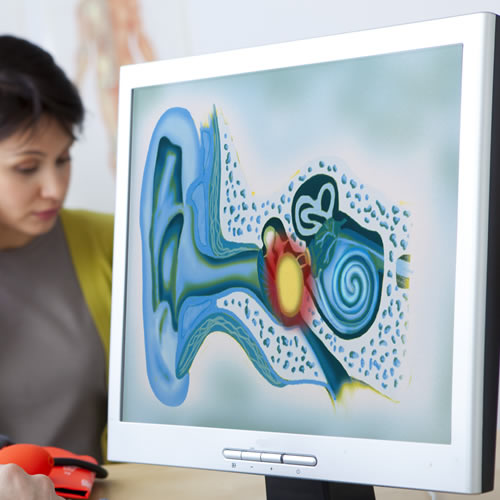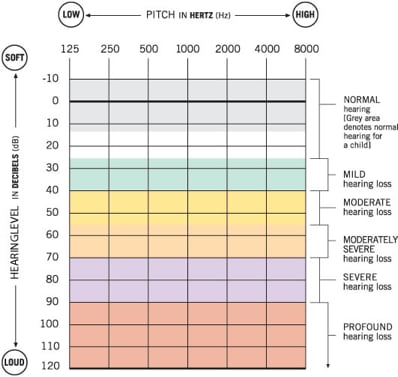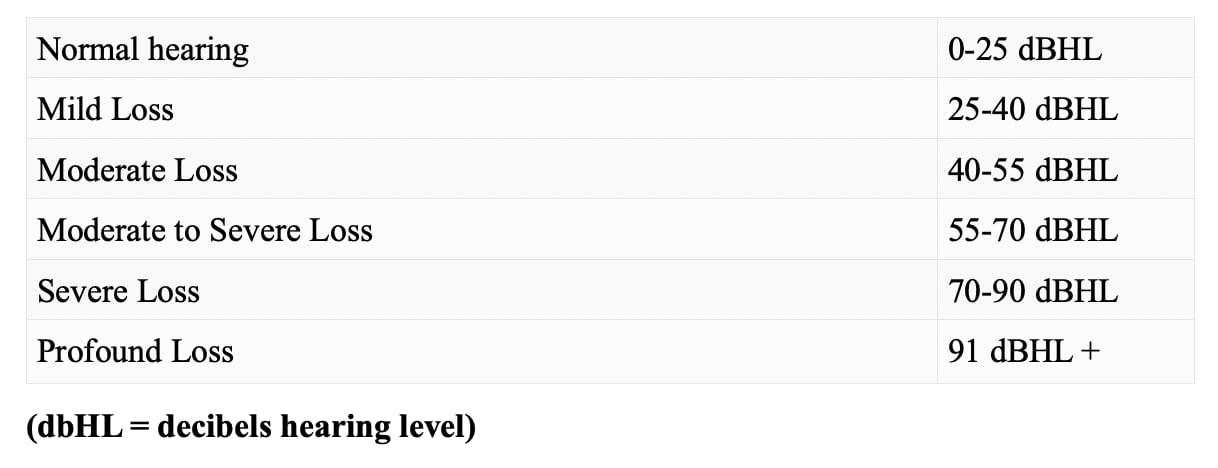 Hearing tests are used to determine the type and degree of hearing loss. The results of the tests are used as a baseline to determine the most appropriate treatment options.
Hearing tests are used to determine the type and degree of hearing loss. The results of the tests are used as a baseline to determine the most appropriate treatment options.
This is the basic hearing test that is performed to determine the softest sounds a client can hear at different pitches, or frequencies. This hearing test is conducted by an audiologist while the client sits in a sound-treated booth. The test includes an assessment of the middle and inner ear function. The results of the test are recorded on a graph called an audiogram. The audiogram is a "picture" of the softest sound a client can hear at different pitches.
The hearing test results indicate if a client has normal hearing or a hearing loss ranging from mild to profound. The test also determines if the loss is conductive, which means the problem is in the middle ear, or sensorineural, which means the problem is in the inner ear or nerve of hearing.
Sound levels are measured in decibels (dB); 0 dB is the softest level measured during the test, and 120 dB is the loudest level. Hearing loss is categorized based on the intensity/loudness level at which a client is able to hear.


This test is an objective means of assessing the integrity and function of the middle ear system. It is used to determine ear drum mobility, eustachian tube function, acoustic reflex threshold, and ossicular chain integrity and mobility. This test does not require any participation from the patient and is very easy to administer. Acoustic immittance testing is of great importance in the evaluation of adults and children with ear issues.
Immittance testing consists of two parts: tympanometry and acoustic reflex test.
Tympanometry measures the mobility of the eardrum. Tympanometry aids assessment of the outer and middle ear system, including the eustachian tube. Tympanometry is administered by placing a soft probe in the patient’s ear and varying the pressure levels causing the eardrum to move.
Acoustic reflex testing consists of subjecting the ear to a loud sound and determining if it causes a reflexive stiffening of the eardrum due to the tightening of the stapedius muscle in the middle ear. The tightening of stapes muscle is called as an acoustic reflex and the lowest intensity level at which this occurs is called as the acoustic reflex threshold. Acoustic reflex test results give the clinician valuable information regarding the severity of your hearing loss and the possible cause of your hearing loss. It is also a valuable test in detecting problems in the auditory pathway.
Specialized diagnostic testing such as Auditory Brainstem Response (ABR), Electrocochleography (ECOG), Vestibular Evoked Myogenic Potentials (VEMP) and Videonsytagmography (VNG) can be used to help determine the cause of hearing loss, tinnitus, ear fullness, dizziness, and other conditions.
Auditory Brainstem Response (ABR) is a widely used objective test to assess hearing sensitivity and auditory nerve function. Auditory neural activity in response to auditory stimuli (using inserts or headphones) is recorded using electrodes taped to the forehead and ears. Patient participation is not required during the test. The entire test procedure takes approximately one hour.
ECOG measures the electrical potentials generated in the inner ear in response to auditory stimulation. Adhesive electrodes are taped to the forehead and ears. A special soft electrode is placed in the ear canal. A series of loud sounds are delivered to the ear through insert phones. Patient participation is not required during the test. The entire process takes approximately one hour.
VEMP testing provides ear specific information about otolith and vestibular nerve function. VEMP response is evoked in response to loud acoustic stimuli. Cervical Vemp (cVEMP) is recorded from the sternocleidomastoid muscle and is used to assess the saccule and inferior vestibular nerve. Ocular Vemp (oVEMP) testing is performed with electrodes placed under the patient’s eyes, and is used to assess the utricle and superior vestibular nerve.
VNG test measures eye movements to evaluate signs of vestibular dysfunction or neurological problems. VNG is a test that uses a camera to track quick eye movement called nystagmus in response to certain visual cues and positional changes. VNG has become a standard in balance assessment and uses infrared video technology to record eye movement while the patient's eyes are open in darkness. VNG test involves conducting oculomotor tests, positional and positioning tests, and/or caloric tests.
Downloadable Patient Instruction Documents
Hearing loss in infants is now diagnosed more frequently due to the neonatal screening programs. As per the National Institute on Deafness and Other Communication disorders, approximately 12,000 new babies are diagnosed with a hearing loss. All newborns undergo an ABR screen in the hospital. If a newborn does not pass the test, he/she is referred for a diagnostic audiological evaluation. The audiologists at EARS Inc. are highly skilled in the work-up and diagnosis of hearing loss in infants. Our evaluation includes state of the art diagnostic testing with ABR, ASSR, Immittance and OAE testing. ABR, ASSR and OAE tests provide information about the integrity of specific sites within the auditory system. Behavioral tests like Visual Reinforcement Audiometry and Conditioned Play Audiometry tests provide a direct measure of hearing. The choice of hearing tests depends on the infant’s age. The ultimate goal is to determine if the child has sufficient hearing for age appropriate speech and language development.
ABR: Auditory Brainstem Response (ABR) is a widely used objective test to assess hearing sensitivity and auditory nerve function. While testing an infant, we look for the lowest intensity at which a repeatable waveform can be produced. Auditory neural activity in response to auditory stimuli (using inserts or headphones) is recorded using electrodes taped to the forehead and ears. The ABR test is a non-invasive procedure and does not require active cooperation from the patient. Infants are tested using sedation or under natural sleep.
ASSR: Auditory Steady State Response (ASSR) is an objective test used to estimate hearing thresholds in children who are too young for conventional hearing testing. Adhesive electrodes taped to the forehead and ears are used to record the response to the auditory stimuli. ASSR test is conducted under natural sleep or with the use of sedation.
OAE: Otoacoustic Emissions (OAE) are acoustic signals generated by the normal inner ear, either in the absence of acoustic stimulation (spontaneous emissions) or in response to acoustic stimulation. OAE’s can be measured by presenting sound through a probe, which is inserted in the outer ear canal. Emissions generated by the outer hair cells of the healthy cochlea are reflected back through the middle ear to the outer canal. The resulting sound is picked up by the probe microphone and processed by a special software and hardware. Emissions test is conducted in a quiet room and requires no participation from the patient. They are used in the diagnosis of hearing loss from infancy to adulthood.
Visual Reinforcement Audiometry (VRA): VRA is used to test hearing of infants and toddlers between 6 months to 2 years. When VRA is used, a head turn response following an auditory stimulus is rewarded with an interesting visual event or reinforcer, such as an animated toy. This test is well suited for normally developing infants and toddlers. Sound is presented through insert earphones or through sound field speakers. A test assistant is used during the test to help the child focus on the visual reinforcer following the acoustic stimulus.
Conditioned Play Audiometry: Conditioning play audiometry (CPA) is used to test children between age of two (2) and four (4). It is a form of instrumental/operant conditioning in which a child is taught to wait and listen for a stimulus. The child is then to respond by performing a motor task in response to the stimulus. For example, the child is taught to put a block in the bucket every time a sound is heard. Sound is presented through insert earphones or through sound field speakers. A test assistant is used during the test to help the child understand the task. After the child understands the task, softer sounds are presented to find the lowest level at which a response is obtained.